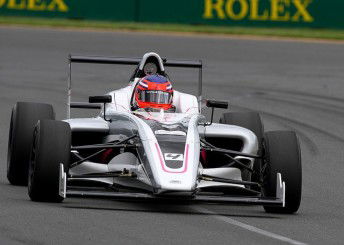

Confederation of Australian Motor Sport CEO Eugene Arocca has staunchly defended the model chosen to introduce the FIA Formula 4 category to the country next season.
The governing body last week revealed further details regarding the new category, which is set to begin in June/July next year and race on the V8 Supercars support card.
CAMS confirmed it has purchased 20 Mygale F4 cars from the French manufacturer, which will then be leased to competitors at a cost of $40,000 per season, plus GST.
According to several interested teams contacted by Speedcafe.com, other already announced costings for championship registration, race entries and testing will almost double that figure, before further expenses for running costs and travel are added.
CAMS has stated that total team expenditure will be “capped” at $170,000 per season, although Arocca confirmed to Speedcafe.com that spending will not be policed.
Arocca is confident CAMS can recoup the funds spent to purchase the cars within three years, even if they fail to license all 20 seats in the first year.
The decision to outlay such an unprecedented amount of money on the start-up category, as well as committing to managing the class, has been met with a mixed reaction from CAMS members and other categories.
“We reckon by offering a license agreement system where you hand the car back at the end of the year in reasonably good condition along with all the other benefits we provide, will pave the way for people to be able to run for a lot less than $170,000,” Arocca told Speedcafe.com.
“Some of the uninformed people have made all sorts of spurious claims about membership money and how we are investing this.
“We have always been a responsible commercial and regulatory entity.
“We take a view that by buying cars that have a life of six years, which we know we will cover the costs of those cars within three years, it is a fantastic investment for us.
“If we don’t end up utilising all 20 cars we have modelled our financials to ensure that in spite of that we would still be in a reasonably solid position.
“The naysayers and the uniformed out there who continually often put their own interests ahead of the sport should cool their jets and give this a chance.”
Ellery Motorsport is among 49 to have submitted an expression of interest to CAMS ahead of the official open of registrations today.
After assessing the costs team owner Luke Ellery believes it would be difficult to run a driver for less than $200,000 a year, once all expenses are considered.
“When factoring in running costs we’ve got to a number of $203,000 on a best case situation with no damage so there would have to be some sort of subsidisation somewhere, many people are wondering where it will come from,” said Ellery, who currently runs cars in Formula Ford.
“Formula 3 is in that price range to do the championship properly and people are spending close to $200,000.
“I’d love to be proven wrong with numbers and see open wheel in Australia flourish, and I would look at running one if the numbers were realistic, but at the moment I personally couldn’t commit.
“There are a lot of advocates of open wheel racing in Australia and we all want to see more F1 stars representing our country, we also want to see CAMS hit the numbers they originally proposed which was $150,000 a season.”
Designed by the FIA as a platform to fit in between karting and Formula 3, the Formula 4 category has also caught the attention of leading karting team Patrizicorse.
Team owner Michael Patrizi admitted he is interested in running an F4 team in the future and is confident CAMS have made the right call on pricing.
“There are a lot of things that haven’t been announced so its difficult to put a figure on it but from what I see its a great chance for young drivers to have a pathway up the ladder,” former V8 Supercars driver Patrizi told Speedcafe.com.
“To do Formula 4 in Europe is €200,000 ($290,000) excluding testing so I do not think the Australian championship is too expensive from what I can see.
“Let’s be realistic, if anything in Australia it should cost a bit more because we have got to travel further to do our racing, so we are very privileged to have someone like CAMS give the kids the opportunity they are going to receive.”
CAMS is yet to unveil the control engine, tyres and calendar for the inaugural season.
The fleet of 20 cars are expected to arrive in Melbourne in early 2015.
See below for an open letter from Eugene Arocca to CAMS members in defence of F4
Dear Members,
Under its constitution CAMS is required to promote and encourage motor sport in Australia. As part of this obligation, it is one of the objectives of CAMS to have a modern, deliverable pathway for driver development. The introduction of FIA Formula 4 has provided CAMS with the ideal opportunity to use this new category as one of the major steps in the developmental pathway. It is therefore no surprise that Australia, along with a number of other countries, will be running a Formula 4 Championship from 2015.
In order to guarantee the availability of cars, CAMS will purchase sufficient Formula 4 cars to conduct a successful CAMS Australian Formula 4 Championship. CAMS will retain ownership of these cars and provide them to competitors under a licence agreement which will clearly stipulate the conditions under which they may be used. CAMS has determined that this is the best way to ensure that this important developmental category provides a ‘level playing field’ in Formula 4 and is also subject to cost control.
From a commercial point of view, the revenue stream from the licence agreement will provide CAMS with the opportunity to recover the initial costs of purchase over a very short time (3 years). At the end of that period, CAMS will then have an unencumbered asset comprising Formula 4 cars which can very inexpensively be rebuilt and reused for further Formula 4 championships and/or CAMS Academy training etc.
CAMS has full confidence that this business model will serve the dual aims of providing young drivers with a development pathway and also ensuring prudent use of CAMS reserves.
The CAMS Board takes the responsibility of managing the members’ funds very seriously; this would explain why it has significant cash reserves which are available to invest back into the sport.
In addition, the CAMS Board is required to act responsibly and in accordance with accepted governance principles, including carrying out a risk assessment with financial modelling, both of which have been performed in this case.
Every national sporting body has a responsibility to invest in elite talent development; the flow on effects of such programs are indisputable and one of those is increased participation which in turn leads to more money coming back into the sport to be invested in more programs by the national sporting body. A recent example of this is the AFL deciding to invest $100 million of members’ funds to create the Gold Coast Suns and GWS Giants with the long term aim of growing the sport nationally; the decision to support an affordable elite young driver championship along with driver academies is a necessary responsibility of CAMS.
The historic arrival of Formula 4 in Australia in 2015 is very exciting and a major landmark for motor sport in this country. It represents the perfect opportunity to not only assist elite young talent with an important pathway, but also grow participation in the sport. The negativity espoused by certain sections of the motor sport industry to CAMS’ support of Formula 4 is not only disappointing but short sighted; it represents an attitude founded in “what’s in it for me?” rather than “let’s put the sport first”. The most strident critics have been supporters of Formula Ford, many of whom have a vested commercial interest in supporting a category that is losing traction worldwide as a development category. The misinformation and scaremongering coming from this section of our sport is reflective of an attitude that pushed the annual cost of competing in Formula Ford well above the $200,000 mark, with most of the money not being retained by the sport. Naturally, they would be the first to complain about a category that strives for driver parity and cost control, whilst ensuring that the money generated is put back into the sport.
Over the last two years we have worked very closely with both the Australian Sports Commission and the Australian Institute of Sport to ensure that Australian motor sport has a clear pathway for junior talent backed by a robust development program. In 2014, we committed to achieving both of these objectives which in turn will place us in good stead when arguing for increased government support for junior participation funding across the country.
CAMS is unashamedly committed to ensuring that we always put the sport first and our decision to support this important category and increase the number of CAMS Academy camps held every year are prime examples of that commitment; we expect the rest of the motor sport community to get behind us as we embark on an exciting phase in the evolution of motor sport in Australia.
Thankyou
Eugene Arocca
CAMS Chief Executive Officer






















Discussion about this post